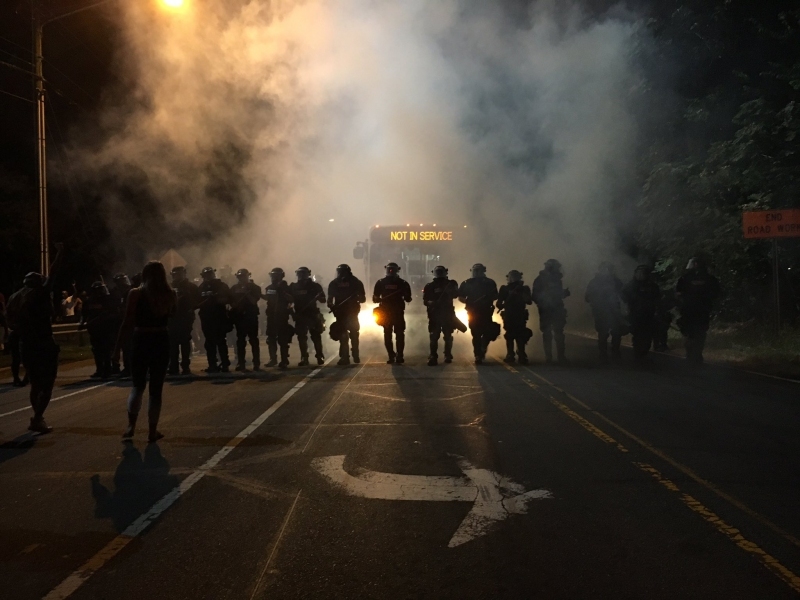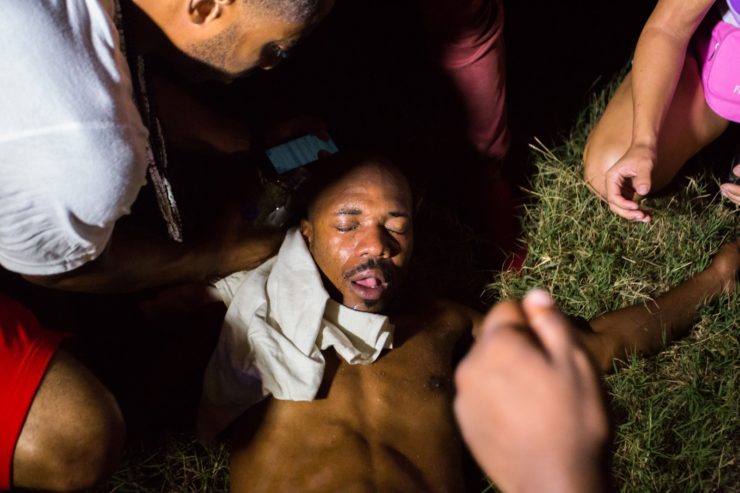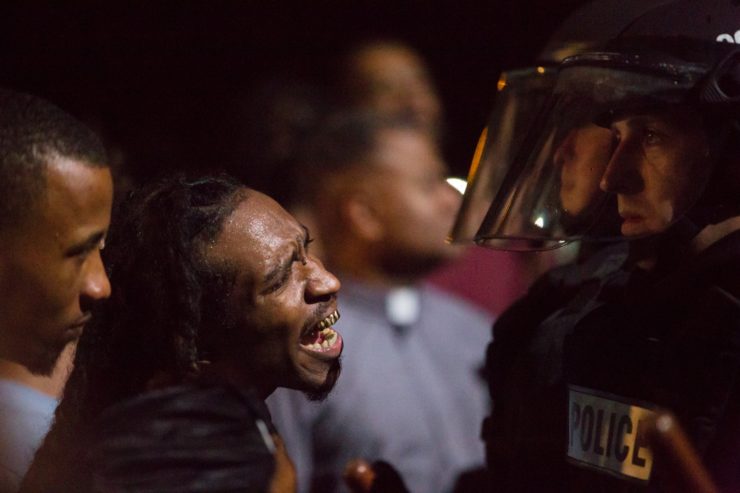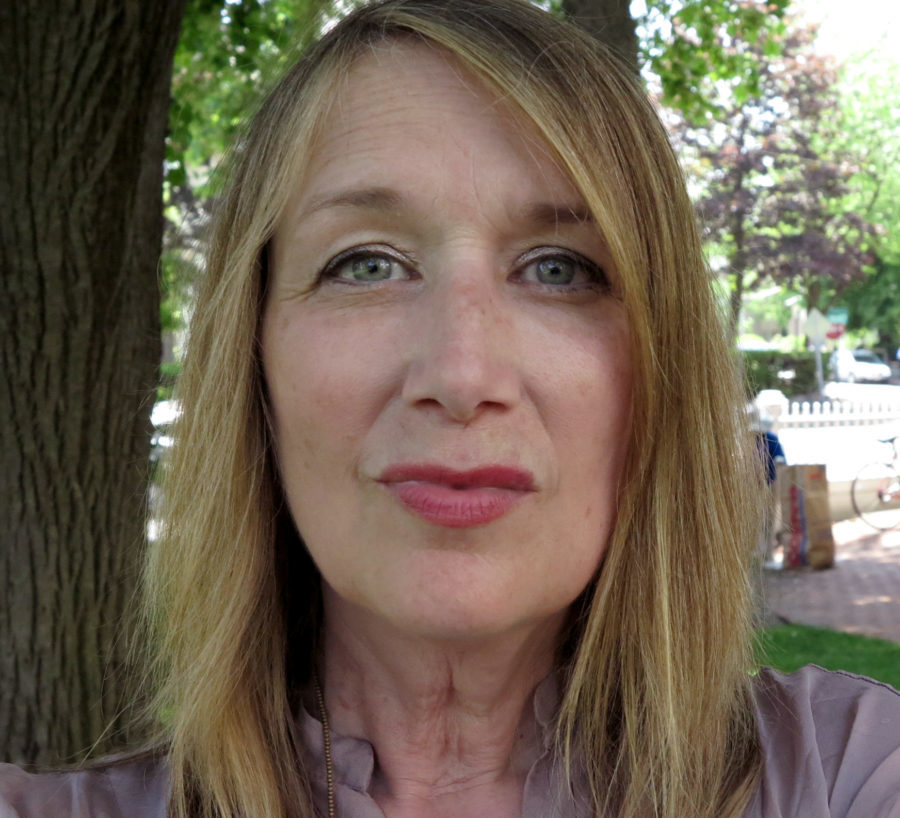
Reporter Adam Rhew took this photo of the unrest, which went viral after he posted it on Twitter.
Last week on Storyboard, I chatted with Brian Kevin of Down East magazine about a wonderful story that ran in the Maine-based publication last year. He talked about the constant juggling — I’m picturing five balls in the air, with maybe a unicycle in the mix — that goes on at a small-staffed regional magazine.
I’d like to keep that theme going, because most journalists don’t work at The New York Times or The New Yorker or in newsrooms with several hundred people, like my old paper, the Los Angeles Times. Most work for small-city dailies or TV stations. Or small-town and alternative weeklies. Or magazines with a full-time staff in the single digits. And doing cool work that often goes under the journalism radar.
Which brings me to Charlotte Magazine and its coverage of the unrest in the wake of yet another fatal police shooting of a black man. Its editor, Michael Graff, dropped me a line about how proud he was of his coverage. I took a look and thought it was worth a post about how a monthly magazine known more for giving you “the best restaurants and places to live” went beyond that to cover something that has become all too common in recent years for American news outlets: police shootings and Black Lives Matter protests.
I emailed with Michael about the coverage. The answers have been slightly edited.
You told me that you developed a document after the Orlando shootings titled, “If it happens here,” making the commitment that if something big happened, you wouldn’t be on the sidelines. What was the game plan outlined in the document? And did it work in real life?
I guess that’s the sad reality today. We started talking about it, generally, before Orlando. I’d gone to Austin, Texas, for a short vacation in February. An Uber driver asked where I was from. When I said Charlotte, he said, “Oh, is that where all those people got shot in the church?” He was talking about the Charleston shootings at Mother Emanuel, of course, but still it made me realize that it’s not a matter of if something major will happen in Charlotte, but when. Then Orlando happened, and the week after that, we drew up a document with a rough plan. We have three full-time staff editors and two full-time designers. We also have two part-time contributing editors, one of whom is also our digital editor, who contribute to our magazine and site several times a week.
The “If it happens here” document roughly outlines what each person would do in the first three days after a major event, if everyone’s even available. On Day 1, I would stay back with our digital editor and steer things, and everybody else would be out in the field. On Day 2, I’d write an overview piece. Day 3, we’d scale back. Roughly.
“A lot of regional magazines worry that they’ll lose readers or hurt their brand if they cover difficult topics. That may be true, in some cases. But I think of our city and region’s media scene as an ecosystem. We all have to play our part.”
I’m not even sure anyone gave the document much thought. And of course news doesn’t care what a Google document says. Very little about the Keith Scott shooting and fallout happened like we’d planned. But I think the important thing was that we’d talked about it, and we’d all agreed as a staff that if something big happened in our city, we weren’t going to sit back and say, “Aw, we’re the magazine that gives you the best restaurants and places to live.” We’d be involved. We have a team of journalists, and we knew it was our job to provide — whether in the monthly magazine or online — a little perspective.
You produced more than a dozen stories, a photo essay and a mini-documentary in the days after the shooting, all while putting out your November edition. Take me into the newsroom (do you work out of a newsroom?) and show me how you managed that.
I wouldn’t call our office a newsroom. We’ve all worked in newsrooms at some point, and that’s not what our place is — at least not yet. We don’t have a police scanner or even a television. The newsroom, I guess, became our phones. And the general attitude was a sense of purpose and devotion to this town we love.
Around 5 p.m. on Tuesday, Sept. 20, we were moving along with our usual deadline week, sending the November issue to the printer. I had a stack of proofs on my desk when the initial news release hit our email, saying a cop had shot and killed a man in the University City area, about 15 miles north of our office. The language in the email was a little defensive, it seemed, so I forwarded it to Greg Lacour, our contributing editor who’s been working on stories about community policing. I brought a stack of proofs home that night. I was sitting on my porch reading them when Greg texted and said, “CMPD may have a problem here.” In the next hour or so, protesters gathered. I sent a quick text to Logan Cyrus, who was our full-time photographer until he left the magazine to go freelance full-time in January 2015. (Our parent company didn’t fill his position.) Logan responded quickly: “For time’s sake, do you know where this is?” He was in the car before I could tell him. I asked him to let me know what was happening. He said, “Assuming it’ll be not much.”
Soon, Greg got in his car, too. So we had two freelancers down there to cover it, not because they had an assignment from me, but because they didn’t know what else to do. Then, around 10:30 or so, I was refreshing Twitter when I saw our associate editor, Adam Rhew, pop up, saying he’d gone there, too. So now we had three people down in a place where cops were in riot gear, all without me asking them to go.
I knew my role then was for them to have someone to talk to. I sat on my couch, and they sent updates and photos to me through the night. I posted a brief first story that basically said, “This happened, this is what we know, and we’ll have updates throughout the day Wednesday.” I told Adam, Greg, and Logan that I’d stay awake as long as they were out there.

People help a protester who was overcome by tear gas.
Before midnight, Adam’s “Not In Service” photo was going viral on Twitter. At about 3:30 a.m., Logan sent a Dropbox with about 20 photos, which we ran as a photo essay. Greg filed his first story, a brilliant perspective piece we called “Charlotte’s Violent Night” at about 4:15 a.m. Adam was on CNN at 4:30. Adam didn’t sleep that night, and the rest of us got less than two hours.
The next day, I went to a news conference with the mayor and police chief at 9:30 a.m. Kristen Wile, our senior editor, was already moving November proofs along. We brought in an emergency proofreader to help make sure our tired eyes didn’t let anything through. And our design team, Jane Fields and Katie Gates, hustled to make sure nothing slowed down. They also began to make adjustments to our November cover. Looking back, I still choke up at that, because we’ve tried to fill our little office with people who can’t help but run toward the fire. It’s cliché, but it feels like family.
Believe it or not, we’d labeled the November issue “The Love Issue” months ago. The point was to have good and positive love stories for people to read during the final weeks of this ridiculous and unsettling election. But as the protests carried on, we knew we had to mention the unrest in the November issue. We took a little of our online coverage and squeezed it in. I scrapped and rewrote my November editor’s note. And we tweaked the cover, just a bit. As the week went on, “The Love Issue” started to take on a different meaning altogether.
You’re a monthly magazine, not a breaking-news outlet. How have your coverage decisions and even your role in the community changed in recent years with the speeding up of the news cycle?
The shift started in 2012, before I worked for the magazine, when Charlotte hosted the Democratic National Convention. The staff covered that event online. That continued after I got here whenever something big happened — when the mayor got arrested for corruption, for instance, in 2014. Or when the Panthers made their Super Bowl run last year. We try to find our place in those conversations.
A lot of regional magazines worry that they’ll lose readers or hurt their brand if they cover difficult topics. That may be true, in some cases. But I think of our city and region’s media scene as an ecosystem. We all have to play our part. We can’t produce the volume of stories that The Charlotte Observer does, obviously, but we can find our space. Since the magazine was founded in the 1960s, we’ve tried to be a time capsule for Charlotte, something you can look back on and say, “This was what it was like to live there at that time.” We provide context and perspective. That doesn’t change now, with the internet. It just means that sometimes we have to do it faster.

A protester confronts a police officer.
As a former newspaper reporter, I recognize that we couldn’t sit back and write these perspectives and deeper dives without the newspaper. If the Observer and the TV folks weren’t there to cover daily news — covering council meetings and digging through documents daily — we couldn’t do what we do, and our city would be weaker. We all have a role.
One of the most memorable photos of the unrest was taken not by a photographer, but by one of your reporters — with his iPhone. That says a lot about the changing world of journalism, don’t you think?
That’s a funny story, and yeah, I guess it is sort of a statement on journalism today. Adam is a writer and editor first. But one of the reasons we hired him was his versatility. He’s actually a former television reporter, and his father worked in TV for decades. It shows in Adam’s writing—he loads paragraphs with great visuals and observations. He took the “Not In Service” picture and posted it to his Twitter feed that Tuesday night, just like anyone in the crowd. It quickly went around the world, all on Twitter, before we’d even posted it on our website. Within hours, the Observer posted it to its site. The next morning, The New York Times ran it with its morning newsletter. Also the next morning, several national media outlets asked Adam if he could cover the next few days of the protests — as a photographer.
I guess if there’s a lesson now, it’s that journalists find a way to tell stories, whether with their phones or pens or laptops.
I like how even in the tensest, crazy-breaking-news moments, you stepped back and wrote narratives. Talk about your decision to frame some of your stories that way.
Narrative is what we do. I think everybody who reads our work knows that, and certainly our writers know that. I get frustrated when I see people use the words “stories” and “storytelling” without really knowing what they mean. Stories need to have a beginning, a middle, and an end. Everything else is an article, or a piece, or something else. It’s a fruitless and probably silly fight, but we try to protect the word “story,” as something that takes people to a place and time and pulls them forward with sensory details and narrative tools.
I hadn’t thought about this question before you asked it. But I guess those stories were narratives because narrative is our default. Some of the other things we did — we ran an editorial on Monday that criticized the city’s leadership, something the magazine has rarely, if ever, done — were out of character for us. That was hard, and we had a lot of discussion and even a few arguments over that. Narrative is natural, though.
I also like the decision to include an unexpected point of view. The novelist David Joy, who grew up poor in Charlotte and owns six guns, talks about white privilege. It was your most-read story of that week. Who had the idea for that one?
A big part of our job as editors here is simply to maintain relationships and create an environment and space for good writers. I met David at a local bookstore in 2015 when he came through town promoting his first novel. He was interesting to me, a guy who came to his book event in jeans and a T-shirt and a ball cap with a fishing hook on it, a proud gun owner and resident of the North Carolina mountains. You look at a guy like that and you make assumptions. But when we talked that night, he told me he’d gone to high school in some of Charlotte’s most diverse schools. And, get this, he was a vegetarian. He didn’t fit the stereotype, and we love people like that. That night, I told him that if he ever wanted to write an essay about his hometown, whatever it was, he had all the blank pages we could give him.
He wrote one essay in October 2015, a homespun piece about how Charlotte had changed since he’d moved away. And then, the week of the protests here, he sent me a message to say he was thinking about writing something and wondered if I could look it over for him. I knew that anything he wrote on a complicated subject like police shootings would be great. I didn’t know what he meant by “look it over.” So I read it and started giving him ideas for big publications in Washington or New York that might buy it. I said, “I mean, if it doesn’t work out there, we’ll definitely take it and run it. But we can’t pay what they pay, so look here and here and here.”
And he basically responded, “I think it’ll be more meaningful if it ran in Charlotte. I don’t give a damn about money.”
David did all the work on that essay. It’s good and popular because of him and his ability to see the world in ways that most people can’t. He’s a gifted writer. The only thing we did was try to create a place where people like David want to write. Honestly, that’s not even work. It’s not hard to create an environment around things you love.


